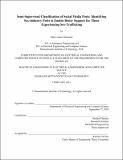Semi-supervised classification of social media posts : identifying sex-industry posts to enable better support for those experiencing sex-trafficking
Author(s)
Simonson, Ellie Louise.
Download1251801646-MIT.pdf (2.279Mb)
Alternative title
Identifying sex-industry posts to enable better support for those experiencing sex-trafficking
Other Contributors
Massachusetts Institute of Technology. Department of Electrical Engineering and Computer Science.
Advisor
Richard Fletcher.
Terms of use
Metadata
Show full item recordAbstract
Social media is both helpful and harmful to the work against sex trafficking. On one hand, social workers carefully use social media to support individuals experiencing sex trafficking. On the other hand, traffickers use social media to groom and recruit individuals into trafficking situations. Additionally, individuals experiencing sex trafficking can use social media as a means to meet sales quotas set by the traffickers [1]. There is the opportunity to use social media data to better provide support for people experiencing trafficking. While Artificial Intelligence and Machine Learning have been used in work against sex trafficking, they predominantly focus on detecting Child Sexual Abuse Material. Work using social media data has not been done with the intention to provide community level support to individuals of all ages experiencing trafficking. Within this context, this thesis explores the use of semi-supervised classification to identify social media posts that are a part of the sex industry¹. Instagram is one of several social media platforms used by individuals within the sex industry, and it was the primary source of data. Several methods were explored for machine learning. However, the primary method used was semi-supervised learning, which has the benefit of providing automated classification with a limited set of labelled data. For this method, social media posts were embedded into low-dimensional vectors using FastText and Doc2Vec models. The data were then clustered using K-means clustering, and Cross-Validation was used to determine label propagation accuracy. The results of the semi-supervised algorithm were encouraging. The FastText CBOW model provided 98.6% accuracy to over 12,000 posts in clusters where label propagation was applied. The results of this thesis suggest that further semi-supervised learning, in conjunction with manual labeling, may allow for the entire dataset containing over 50,000 posts to be accurately labeled. A fully labeled dataset could be used to develop a tool to identify an overview of where and when social media is used within the sex industry. Such a tool could be used to help determine where to provide public resources to support people experiencing trafficking, how to distribute resource funds, and where to provide awareness trainings.
Description
Thesis: M. Eng., Massachusetts Institute of Technology, Department of Electrical Engineering and Computer Science, February, 2021 Cataloged from the official PDF of thesis. "February 2021." Includes bibliographical references (pages 109-111).
Date issued
2021Department
Massachusetts Institute of Technology. Department of Electrical Engineering and Computer SciencePublisher
Massachusetts Institute of Technology
Keywords
Electrical Engineering and Computer Science.